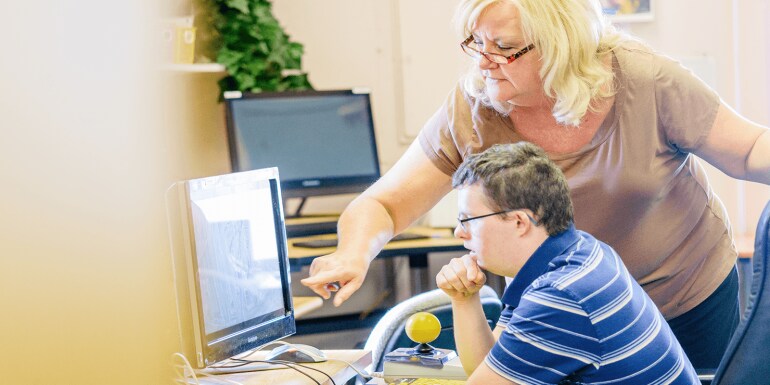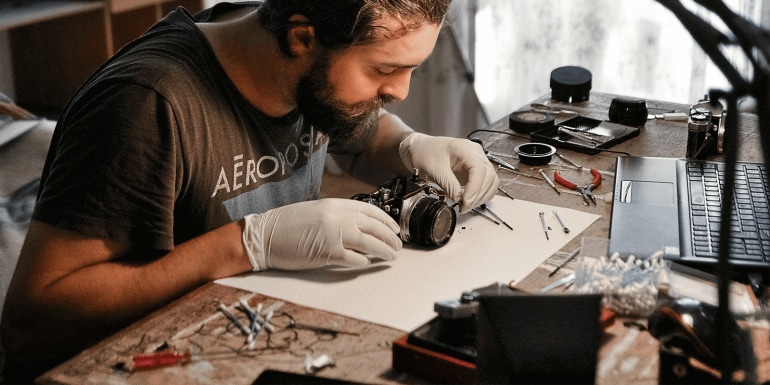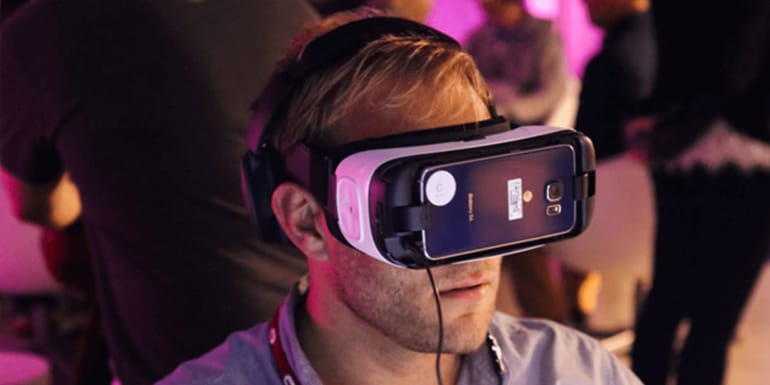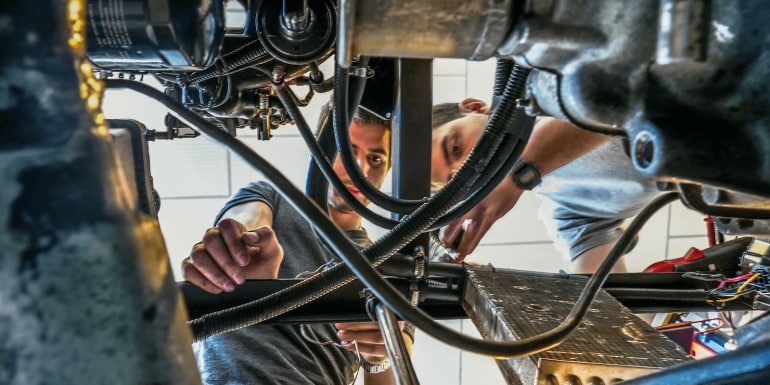This is the fifth in a series of essays surrounding the EdTech Efficacy Research Symposium, a gathering of 275 researchers, teachers, entrepreneurs, professors, administrators, and philanthropists to discuss the role efficacy research should play in guiding the development and implementation of education technologies. This series was produced in partnership with Pearson, a co-sponsor of the symposium co-hosted by the University of Virginia’s Curry School of Education, Digital Promise, and the Jefferson Education Accelerator. Click through to read the first, second, third, and fourth pieces.
Education technology plays an essential role in our schools today. Whether the technology supports instructional intervention, personalized learning, or school administration, the successful application of that technology can dramatically improve productivity and student learning.
That said, too many school leaders lack the support they need to ensure that educational technology investment and related activities, strategies, or interventions are evidence-based and effective. This gap between opportunity and capacity is undermining the ability of school leaders to move the needle on educational equity and to execute on the goals of today’s K-16 policies. The education community needs to clearly understand this gap and take some immediate steps to close it.
The time is ripe
The new federal K-12 law, the Every Students Succeeds Act, elevates the importance of evidence-based practices in school purchasing and implementation practices. The use of the state’s allocation for school support and improvement illustrates the point. Schools that receive these funds must invest only in activities, strategies, or interventions that demonstrate a statistically significant effect on improving student outcomes or other relevant outcomes.
That determination must rely on research that is well designed and well implemented, as defined in the law. And once implementation begins, the U.S. Department of Education asks schools to focus on continuous improvement by collecting information about the implementation and making necessary changes to advance the goals of equity and educational opportunity for at-risk students. The law, in short, links compliance with evidence-based procurement and implementation that is guided by continuous improvement.
New instructional models in higher education rely on evidence-based practices if they are to take root. School leaders are under intense pressure to find ways to make programs more affordable, student-centered, and valuable to a rapidly changing labor market. Competency-based education (the unbundling of certificates and degrees into discrete skills and competencies) is one of the better-known responses to the challenge, but the model will likely stay experimental until there is more evidence of success.
“We are still just beginning to understand CBE,” Southern New Hampshire University President Paul LeBlanc said. “Project-based learning, authentic learning, well-done assessment rubrics — those are all good efforts, but do we have the evidence to pass muster with a real assessment expert? Almost none of higher ed would.”
It is easy to forget that the abundance of educational technology is a relatively new thing for schools and higher ed institutions. Back in the early 2000s, the question was how to make new educational technologies viable instructional and management tools. Education data was largely just a lagging measure used for school accountability and reporting.
Today, the data can provide strong, real-time signals that advance productivity through, for example, predictive analytics, personalized learning, curriculum curating and delivery, and enabling the direct investigation into educational practices that work in specific contexts. The challenge is how to control and channel the deluge of bytes and information streaming from the estimated $25.4 billion K-16 education technology industry.
“It’s [now] too easy to go to a conference and load up at the buffet of innovations. That’s something we try hard not to do,” said Chad Ratliff, director of instructional programs for Virginia’s Albemarle County Schools. The information has to be filtered and vetted, which takes time and expertise.
Improving educational equity is the focus of ESSA, the Higher Education Act, and a key reason many school leaders chose to work in education. Moving the needle increasingly relies on evidence-based practices. As the Aspen Institute and Council of Chief State School Officers point out in a recent report, equity means — at the very least — that “every student has access to the resources and educational rigor they need at the right moment in their education despite race, gender, ethnicity, language, disability, family background, or family income.”
Embedded in this is the presumption that the activities, strategies, or interventions actually work for the populations they intend to benefit.
Educators cannot afford to invest in ineffective activities. At the federal K-12 level, President Donald Trump is proposing that, next year, Congress cut spending for the Education Department and eliminate many programs, including $2.3 billion for professional development programs, $1.2 billion for after-school funds, and the new Title IV grant that explicitly supports evidence-based and effective technology practices in our schools.
Higher education is also in a tight spot. The president seeks to cut spending in half for Federal Work-Study programs, eliminate Supplemental Educational Opportunity grants, and take nearly $4 million from the Pell Grant surplus for other government spending. At the same time, Education Secretary Betsy DeVos is reviewing all programs to explore which can be eliminated, reduced, consolidated, or privatized.
These proposed cuts and reductions increase the urgency for school leaders to tell better stories about the ways they use the funds to improve educational opportunities and learning outcomes. And these stories are more compelling (and protected from budget politics) when they are built upon evidence.
Too few resources
While this is a critical time for evidence-based and effective program practices, here is the rub: The education sector is just beginning to build out this body of knowledge, so school leaders are often forging ahead without the kind of guidance and research they need to succeed.
The challenges are significant and evident throughout the education technology life cycle. For example, it is clear that evidence should influence procurement standards, but that is rarely the case. The issue of “procurement standards” is linked to cost thresholds and related competitive and transparent bidding requirements. It is seldom connected with measures of prior success and research related to implementation and program efficacy. Those types of standards are foreign to most state and local educational agencies, left to “innovative” educational agencies and organizations, like Digital Promise’s League of Innovative Schools, to explore.
Once the trials of implementation begin, school leaders and their vendors typically act without clear models of success and in isolation. There just are not good data on efficacy for most products and implementation practices, which means that leaders cannot avail themselves of models of success and networks of practical experience. Some schools and institutions with the financial wherewithal, like Virginia’s Albemarle and Fairfax County Public Schools, have created their own research process to produce their own evidence.
In Albemarle, for example, learning technology staff test-bed solutions to instructional and enterprise needs. Staff spend time observing students and staff using new devices and cloud-based services. They seek feedback and performance data from both teachers and students in response to questions about the efficacy of the solution. They will begin with questions like “If a service is designed to support literacy development, what variable are we attempting to affect? What information do we need to validate significant impact?” Yet, like the “innovators” of procurement standards, these are the exceptions to the rule.
And as schools make headway and immerse themselves in new technologies and services, the bytes of data and useful information multiply, but the time and capacity necessary to make them useful remains scarce. Most schools are not like Fairfax and Albemarle counties. They do not have the staff and experts required to parse the data and uncover meaningful insights into what’s working and what’s not. That kind of work and expertise isn’t something that can be simply layered onto existing responsibilities without overloading and possibly burning out staff.
“Many schools will have clear goals, a well-defined action plan that includes professional learning opportunities, mentoring, and a monitoring timeline,” said Chrisandra Richardson, a former associate superintendent for Montgomery County Public Schools in Maryland. “But too few schools know how to exercise a continuous improvement mindset, how to continuously ask: ‘Are we doing what we said we would do — and how do we course-correct if we are not?’ ”
Immediate next steps
So what needs to be done? Here are five specific issues that the education community (philanthropies, universities, vendors, and agencies) should rally around.
- Set common standards for procurement. If every leader must reinvent the wheel when it comes to identifying key elements of the technology evaluation rubric, we will ensure we make little progress — and do so slowly. The sector should collectively secure consensus on the baseline procurement standards for evidence-based and research practices and provide them to leaders through free or open-source evaluative rubrics or “look fors” they can easily access and employ.
- Make evidence-based practice a core skill for school leadership. Every few years, leaders in the field try to pin down exactly what core competencies every school leader should possess (or endeavor to develop). If we are to achieve a field in which leaders know what evidence-based decision-making looks like, we must incorporate it into professional standards and include it among our evaluative criteria.
- Find and elevate exemplars. As Charles Duhigg points out in his recent best seller Smarter Faster Better, productive and effective people do their work with clear and frequently rehearsed mental models of how something should work. Without them, decision-making can become unmoored, wasteful, and sometimes even dangerous. Our school leaders need to know what successful evidence-based practices look like. We cannot anticipate that leader or educator training will incorporate good decision-making strategies around education technologies in the immediate future, so we should find alternative ways of showcasing these models.
- Define “best practice” in technology evaluation and adoption. Rather than force every school leader to develop and struggle to find funds to support their own processes, we can develop models that can alleviate the need for schools to develop and invest in their own research and evidence departments. Not all school districts enjoy resources to investigate their own tools, but different contexts demand differing considerations. Best practices help leaders navigate variation within the confines of their resources. The Ed Tech RCE Coach is one example of a set of free, open-source tools available to help schools embed best practices in their decision-making.
- Promote continuous evaluation and improvement. Decisions, even the best ones, have a shelf life. They may seem appropriate until evidence proves otherwise. But without a process to gather information and assess decision-making efficacy, it’s difficult to learn from any decisions (good or bad). Together, we should promote school practices that embrace continuous research and improvement practices within and across financial and program divisions to increase the likelihood of finding and keeping the best technologies.
The urgency to learn about and apply evidence to buying, using, and measuring success with ed tech is pressing, but the resources and protocols they need to make it happen are scarce. These are conditions that position our school leaders for failure — unless the education community and its stakeholders get together to take some immediate actions.
This series is produced in partnership with Pearson. The 74 originally published this article on September 11th, 2017, and it was re-posted here with permission.









